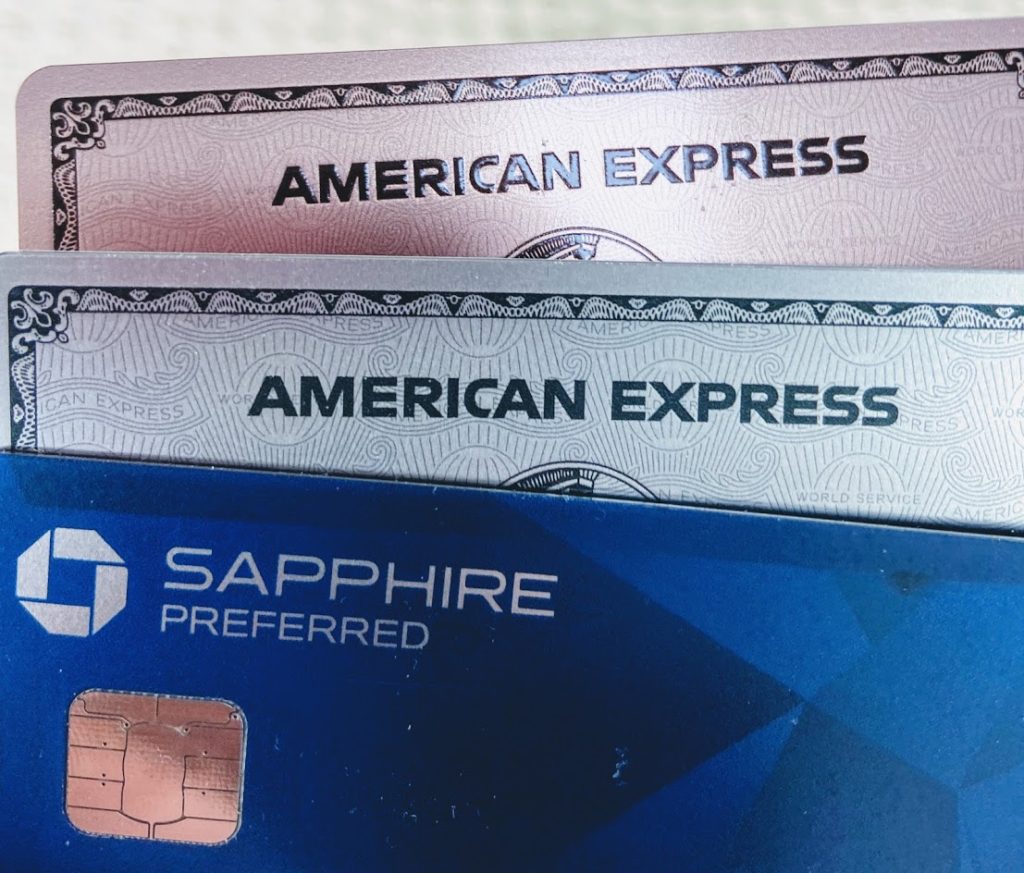There are so many ways to accumulate points and miles to use for travel these days. We’re often asked which credit cards are best. Based on our experiences converting points to free travel, the best choices are the cards that accumulate their own unique, transferable rewards points. These cards provide the most flexibility for use with airlines and hotels, as well as some of the best values per point.
If you could only have two cards in your wallet, we would recommend the American Express Gold Card and the Chase Sapphire Preferred Card. Each of these cards generates unique rewards points that are transferable to multiple travel partners. This flexibility, coupled with the fastest and easiest transfers, make these our go-to card recommendations. If you can justify the higher annual fee of premium cards with the great benefits that come with them, the American Express Platinum Card and the Chase Sapphire Reserve Card would be our picks.
That doesn’t mean you should cut up your favorite airline cards. . .use those when you’re buying tickets from that airline and receive a multiple of 2X to 5X the dollar amount you charge in miles. Those cards should also get you a free bag or two plus preferred boarding and other perks. Ditto for your hotel cards. . .use them when you stay and pay for your room and other charges. The multiples here are even better; between 3X and 12X for each dollar you spend, depending on the brand and the card you use.
For the rest of your everyday spending, use the card that fits your travel preferences. Here’s how you can figure that out:
- The American Express Membership Rewards program has the following airline travel partners: Delta, JetBlue, Air Canada, plus thirteen other international airlines. Hotel partners are Marriott, Hilton and Choice. Points transfer at a 1:1 ratio, except for JetBlue (1:0.8) and Hilton (1:2). Most transfers take place immediately; some of the international airlines can take up to 48 hours.
- The Chase Ultimate Rewards program has more domestic airlines as partners: United, Southwest and JetBlue, plus five other international carriers. Hotel partners are Marriott, Hyatt and IHG. All points transfer at a 1:1 ratio within 48 hours (most transfers are instantaneous).
Note that American Airlines is not a direct transfer partner for either of these programs. Because they are part of the oneworld Alliance program, you can transfer points to another oneworld Alliance carrier and book award travel on American. Both American Express and Chase have oneworld travel partners.

Photo by Troy Mortier on Unsplash
So there are your choices. If you like to fly Delta and stay at Hilton, the American Express cards are the way to go. If you prefer to fly United and stay at a Hyatt, pick the Chase cards. But what if your favorite airline is in one program and your favorite hotel is in the other? If you don’t want to get both cards, pick the one that includes your preferred airline, because that’s where you’ll find the best value. Round trip first class and business class tickets for international travel typically cost $3,000-$10,000 per person. You can usually book that same ticket for 110,000 to 160,000 miles, so you’re getting between two and six cents’ value per point. For main cabin or economy class flights, the value per point is not as high, but would still be in the one to three cent range. Because hotel points have been consistently devalued over the last few years, and cash prices are depressed because of the pandemic, it’s very difficult to get over a penny a point when using your points for hotel stays. Pick the card that matches up with the airlines you use the most.
Of course, every one of us has different goals and preferences, so there may be other cards or combinations that are worth considering. But if you’re like most travelers, this basic approach will help you save big on travel. If you don’t have these cards in your wallet, the sign-up bonuses for each of them are at or near their highest levels ever. That’s the best way to stock up on the points that can benefit you the most. But you should act quickly, since those sign-up bonuses are predicted to end around May 22.
Two fine points on applying for these valuable credit cards: If you’re interested in either of the Chase cards, apply for those first. Chase has an unpublished rule (the dreaded “5/24 rule”) that limits new cards to those customers that have opened five or fewer personal credit cards from ANY issuer in the previous 24 months. American Express has some limitations for new cards, but they’re far less onerous than the 5/24 rule. With Amex, you need to keep in mind that you can only receive a sign-up bonus for one of their cards once in your lifetime (although lifetime appears to be defined as the last six or seven years). Amex will let you know if you don’t qualify for the bonus before you submit your application.
Finally, if you decide to apply for one of these cards, please use our links to do so:
Please tell us if you’re applying for a new card in the comments section below. And if you have any questions, feel free to email us at phil@theexceptionaltraveler.com.



Pingback: This Week in Travel - May 15, 2021 - theexceptionaltraveler.com
At what point to do you recommend the Platinum over the Gold? Business card vs personal card?
Hi Justin! The Platinum is the better card. . .higher sign up bonus, 10X for groceries and gas in the first six months, better benefits, etc. BUT, you have to be able to justify that expensive annual fee ($550 vs. $250 for the Gold card). If you’ll use the $200 airline incidental credit, the $200 in Uber credits, the $100 in Saks Fifth Ave credits and other credits that come and go through the year, get the Platinum card. If you don’t think you’ll use those credits, you might travel enough to attach a high value to the Amex Centurion Club lounges or the Priority Pass. Or you may be happy with paying that fee to get the 100k sign up bonus that’s worth $2k and drop down to a Gold card after a year.